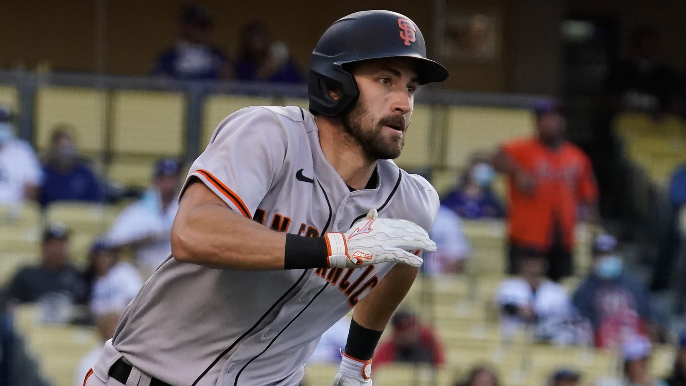
Robert Hanashiro-USA TODAY Sports
Steven Duggar has learned not to look back too far at at-bats, pondering what-ifs, contemplating more patient approaches or more aggressive hacks, wondering why he couldn’t get off the swing he wanted.
He is trying to glue his head forward to resist the rubbernecking that has plagued him. But given enough time, he can remember who he was and who he does not want to be.
He told as much to Gabe Kapler in a text message during spring training. In a sport in which self-confidence is integral, Duggar is a rare type of self-aware, which is endearing to his manager and his Giants teammates.
“I just said, ‘Hey, some of the worst baseball I’ve ever played was last year. It’s behind me — I’m better for it,’” Duggar said he told Kapler in camp. “Hopefully I’m showing him and this team, this organization, that that’s the case.”
In a season that seemed destined to be spent in Sacramento — or on another major league club — Duggar has emerged as a do-everything outfielder, and the “everything” notably includes hitting. His .929 OPS is more than double his mark from last year (.458). His three home runs in 73 plate appearances represent one-third of his career total in 542 plate appearances. His chase rate has plunged, he is driving more balls in the air, and his defense, as it was even in bad seasons, is nothing less than outstanding. His first 29 games of the campaign have resulted in a .324/.370/.559 slashline that has rendered him too valuable to be shuttled back to Triple-A — all during a year that was not supposed to be about a guy who hit .176 last season.
This offseason the Giants added LaMonte Wade Jr., whose plate approach is a more natural fit with the organization. Wade, also a lefty-hitting outfielder, got the first call-up this season. Shortly after lefty-hitting outfielder Mike Yastrzemski hurt his oblique in April, the Giants traded for lefty-hitting outfielder Mike Tauchman, who has a doctorate in seeing pitching.
Duggar understands he did not show enough to justify full confidence. There was an opening last season, as the Giants lacked another lefty bat through the 60-game duration, yet Duggar, who became far too used to the I-80 ride to and from Sacramento, never hit.
“I feel like in years past, there might have been an at-bat where you think about it for a few extra days that kind of leaks into the next day and leaks into the next day, and then you just continue down that rabbit hole. Man, it’s really tough to do. It’s tough to play that way,” Duggar said from the dugout in Los Angeles, in a series in which he homered off of Walker Buehler.
Entering last season, he had retooled his swing to be more upright, harkening back to a stance he used in high school. He abandoned it during the season because he couldn’t find a comfort level.
Yes, he was not seeing enough pitches (a career-low 3.69 per plate appearance); he was not doing damage to the ones he was supposed to (.235 slugging percentage), as the Giants say. But a season later, Duggar can view his struggles with more old-school terminology.
“You’re thinking more mechanically than just playing baseball, you know? I’m good enough to play here,” said Duggar, who totaled seven plate appearances in April, and yet is fifth among Giants position players with a 0.9 WAR. “I was just itching to get back out on the field in spring training and show the staff, the front office, that I’m a player that they can depend on to help them win games.”
His spring training followed a difficult offseason of reflection, of wondering where it went wrong, of more work on a swing that he feels belongs in the majors.
He is trying to focus on the fun — it’s a game — and the process over results. The Giants crave long at-bats that help them win the “time of possession,” as Kapler will tell you. It is less about connecting and more about “giving them a hell of an at-bat, keeping the line moving,” said Duggar, whose pitches per plate appearance is up to 3.89.
There are fewer brutally honest text messages to his manager.
“He has some awareness about what’s happening around him. I also think he’s a pretty harsh critic of himself, and a pretty good self-evaluator,” Kapler said. “He understands when he’s at his best, and he understands when there’s room for improvement. And I appreciate that level of awareness and I think his teammates do, too.”
Duggar can tell you his at-bats are improving, but also can tell you that does not guarantee anything. He has fought his way into prolonged time on a roster that has, at full health, Yastrzemski, Tauchman, Wade, Austin Slater, Alex Dickerson and Darin Ruf, with prospects like Heliot Ramos beginning to campaign for chances, too.
He understands his spot is not assured, even if his swing is trying to dispute that. He is in his final option-able year, and there are not many players who are as accustomed to the demotion conversation as he is.
“You feel the heartbreak. Guys that go up and down, it’s never somewhere you want to be in your career,” Duggar said. “It’s something that you deal with. It’s something that you keep trying to get better, so it doesn’t happen.”
In the small sample size of May, it did not happen. But now that it’s June, forgive Duggar if he does not want to look back.

